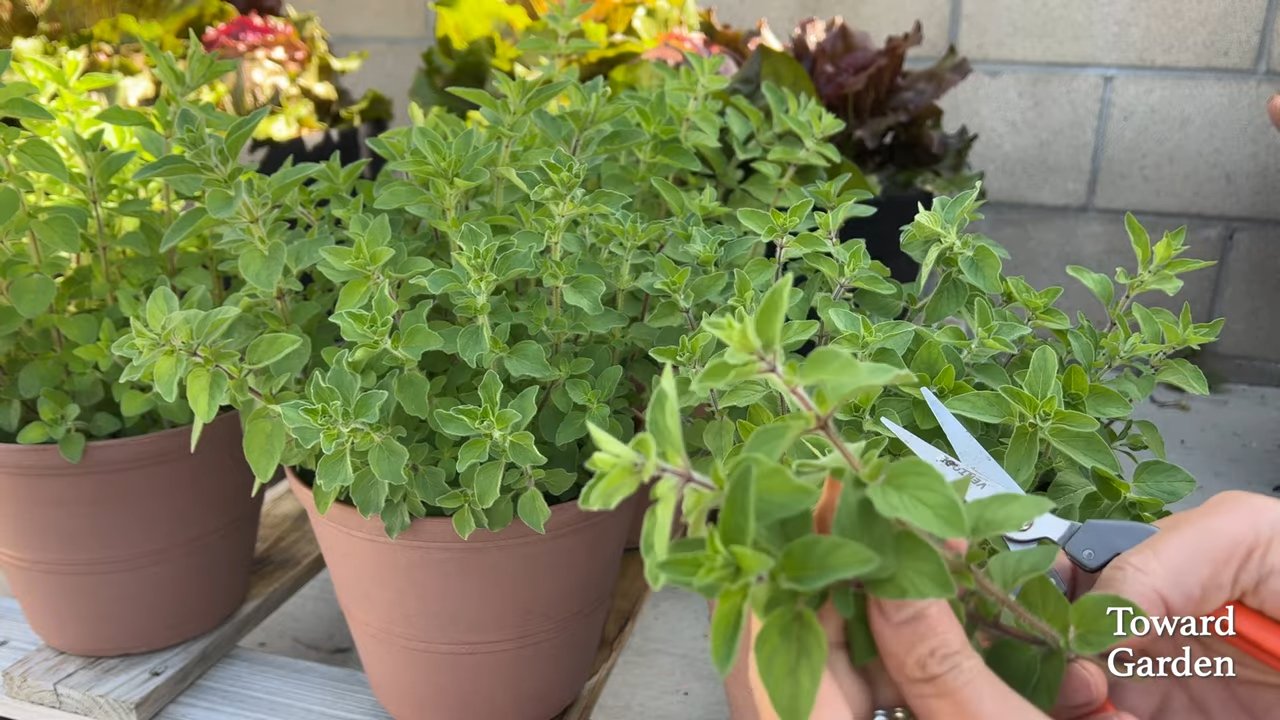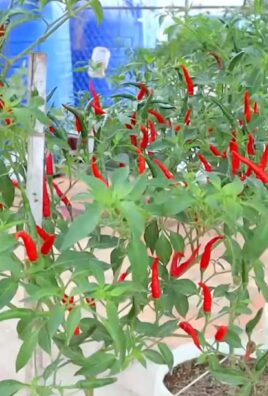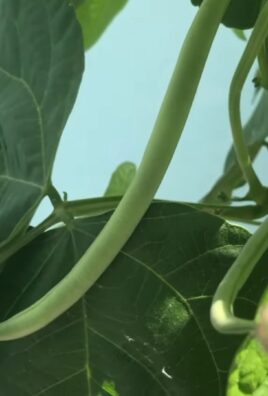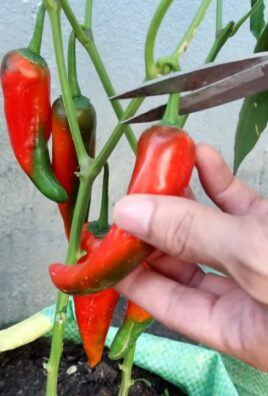Growing Oregano at Home is easier than you might think, and I’m here to show you how! Forget those sad, dried-up flakes from the grocery store – imagine stepping outside your door and snipping fresh, fragrant oregano whenever you need it. Sounds dreamy, right?
For centuries, oregano has been more than just a culinary herb. In ancient Greece, it symbolized joy and happiness, and was often used in wedding garlands. The Romans spread its use throughout Europe, valuing it for both its flavor and medicinal properties. Today, oregano remains a staple in kitchens around the world, adding a zesty kick to everything from pizzas to stews.
But why should you bother with growing oregano at home? Well, for starters, the flavor of fresh oregano is simply unmatched. Plus, it’s incredibly rewarding to nurture your own plants and harvest your own ingredients. And let’s be honest, in today’s world, knowing how to grow your own food, even something as simple as growing oregano at home, feels empowering. This DIY guide will provide you with simple, effective tricks and hacks to cultivate thriving oregano plants, even if you have limited space or gardening experience. Get ready to unleash your inner gardener and enjoy the delicious rewards!

Growing Oregano at Home: Your Simple DIY Guide
Hello, dear garden friends! I’m so excited to show you today how you can easily grow oregano at home. Oregano is not only a super versatile herb in the kitchen but also incredibly easy to care for. Whether you have a large garden, a small balcony, or just a sunny windowsill, oregano will find a spot anywhere. Let’s get started!
What You Need: Your Materials List
Before we begin, here’s a list of everything you’ll need for your oregano project:
- Oregano seeds or an oregano plant: You can either start with seeds or buy a plant that has already grown. Both work great!
- Seed starting pots or small containers: If you’re starting with seeds, you’ll need small pots for germination.
- Potting soil: It’s best to use a high-quality, well-draining potting soil.
- Watering can or spray bottle: For watering your plants.
- A sunny location: Oregano loves the sun!
- Optional: Fertilizer (organic or mineral) for later growth.
- Optional: Scissors or garden shears for harvesting.
Growing Oregano from Seed: Step by Step
If you’ve decided to start with seeds, here is a detailed guide:
- Prepare the seed pots: Fill your seed starting pots with potting soil. Press the soil down lightly, but not too firmly. It should remain loose and airy.
- Sow the seeds: Oregano seeds are very small. Therefore, sprinkle them sparingly on the soil. You can press them down lightly, but do not cover them with soil, as oregano is a light germinator. This means the seeds need light to sprout.
- Watering: Gently moisten the soil with a spray bottle. Avoid washing the seeds away. The soil should be damp, but not wet.
- Location: Place the seed starting pots in a warm and bright place. A sunny windowsill is ideal.
- Germination: The seeds usually germinate within 10-14 days. Keep the soil moist during this time.
- Pricking out: Once the seedlings are large enough (about 5-7 cm / 2-3 inches high and with several pairs of leaves), you can prick them out. This means you transplant each seedling into its own pot or into the garden. Proceed carefully to avoid damaging the roots.
Planting an Oregano Plant: Here’s How
If you’ve bought an oregano plant that has already grown, planting it is even easier:
- Prepare the pot or garden bed: Choose a pot with enough space for the plant’s roots. If you want to plant oregano in the garden, loosen the soil well and remove any weeds.
- Planting: Dig a hole large enough for the plant’s root ball. Place the plant inside and fill the hole with soil. Press the soil down lightly.
- Watering: Water the plant thoroughly so the soil settles around the roots.
- Location: Place the pot or the plant in the garden in a sunny location.
Caring for Your Oregano: Tips and Tricks
Oregano is truly undemanding, but here are a few tips to help it thrive:
- Watering: Oregano doesn’t like it when the soil is constantly wet. Water it only when the top layer of soil is dry. In the summer, this might be more often than in the winter.
- Sunlight: Oregano needs at least 6 hours of sun per day. The more sun, the more aromatic the leaves will be.
- Fertilizing: If you wish, you can fertilize your oregano every few weeks during the growing season (spring and summer) with an organic or mineral fertilizer. Be sure to follow the dosage instructions on the packaging.
- Pruning: Regular pruning promotes growth and prevents the plant from becoming woody. Simply cut the shoots with scissors or garden shears. You can use the cut shoots for cooking or dry them.
- Overwintering: Oregano is hardy, but in very cold regions, it can be a good idea to cover the plant with brushwood or leaves to protect it from frost. If you have oregano in a pot, you can also move it to a cool, bright place.
Harvest Time: How to Harvest Oregano Correctly
Harvesting oregano is super easy and fun!
- When to harvest: You can harvest oregano as soon as the plant is large enough. It’s best to harvest it just before it flowers, as the leaves are most aromatic then.
- How to harvest: Cut the shoots with scissors or garden shears. You can harvest individual leaves or entire shoots.
- How to use: Fresh oregano is, of course, the best, but you can also dry it to make it last longer. Tie the cut shoots into small bundles and hang them in a dry, airy place. Once the leaves are dry, you can crumble them and store them in an airtight container.
Drying Oregano: How to Preserve the Aroma
If you want to preserve your oregano for the winter, drying is a great option. Here are two methods:
Air Drying
- Harvest: Harvest the oregano sprigs in the morning after the dew has evaporated.
- Bundle: Tie small bundles of about 5-10 sprigs together.
- Hang: Hang the bundles upside down in a dry, dark, and well-ventilated place. Avoid direct sunlight, as it can break down the essential oils.
- Drying time: The drying time is usually 1-3 weeks, depending on the humidity. The leaves are dry when they crumble easily.
- Storage: Remove the dried leaves from the stems and store them in an airtight container in a cool, dark place.
Drying in the Oven
- Preheat: Preheat the oven to the lowest setting (ideally below 50°C / 122°F).
- Prepare: Place the oregano sprigs in a single layer on a baking sheet lined with parchment paper.
- Dry: Slide the baking sheet into the oven and leave the oven door slightly ajar to allow moisture to escape.
- Drying time: The drying time is usually 2-4 hours. Check regularly to see if the leaves are dry.
- Storage: Let the dried leaves cool before storing them in an airtight container.
Common Problems and Solutions
Even when growing oregano, problems can arise. Here are a few common issues and how to solve them:
Pests: Oregano is relatively resistant to pests, but occasionally aphids or spider mites can appear. Spray the plant with a mild soap solution to combat the pests.
Yellow leaves: Yellow leaves can be a sign of overwatering or a nutrient deficiency. Reduce the amount of water and fertilize the plant if necessary.

Conclusion
So, there you have it! Growing oregano at home isn’t just a fun project; it’s a gateway to fresher, more flavorful meals and a more sustainable lifestyle. Ditch the dried, often lackluster oregano from the grocery store and embrace the vibrant, aromatic experience of harvesting your own. The difference in taste is truly remarkable – a burst of peppery, slightly minty goodness that elevates everything from pizzas and pastas to grilled meats and vibrant salads.
This DIY trick is a must-try for several compelling reasons. First and foremost, you gain complete control over the quality of your oregano. No more wondering about the source or age of your herbs. You know exactly what you’re getting: organically grown, pesticide-free oregano bursting with essential oils and flavor. Secondly, it’s incredibly cost-effective. A single oregano plant can provide you with a continuous supply of fresh herbs for months, even years, far outweighing the cost of repeatedly purchasing dried oregano. Thirdly, it’s incredibly rewarding. There’s something deeply satisfying about nurturing a plant from a tiny seedling or cutting to a thriving herb that enhances your culinary creations.
But the benefits don’t stop there. Growing oregano at home is also a fantastic way to add a touch of greenery to your living space. Whether you choose to grow it in a pot on your windowsill, in a raised garden bed, or even in a hanging basket, oregano adds a touch of natural beauty to your home. Plus, the aroma of fresh oregano is incredibly uplifting and can help to create a more relaxing and inviting atmosphere.
Ready to take your oregano game to the next level? Consider experimenting with different varieties. Greek oregano is known for its intense flavor, while Italian oregano is slightly milder and sweeter. Mexican oregano, though technically a different species, offers a bolder, citrusy flavor that’s perfect for Southwestern cuisine. You can also try growing variegated oregano, which adds a touch of visual interest with its beautiful green and white leaves.
Don’t be afraid to get creative with your oregano harvest. Beyond using it in your favorite recipes, you can also dry it for later use, infuse it into olive oil, or even use it to make a soothing herbal tea. The possibilities are endless!
We wholeheartedly encourage you to try this DIY trick and experience the joy of growing your own oregano. It’s a simple, rewarding, and delicious way to enhance your cooking and connect with nature. Once you’ve tasted the difference between fresh and dried oregano, you’ll never go back!
And most importantly, we want to hear about your experience! Share your photos, tips, and recipes in the comments below. Let’s build a community of oregano enthusiasts and inspire others to embrace the joys of homegrown herbs. What are you waiting for? Get growing!
Frequently Asked Questions (FAQ)
What is the best way to start growing oregano at home?
There are several ways to start growing oregano. You can purchase oregano seeds and sow them indoors 6-8 weeks before the last expected frost. Alternatively, you can buy a starter plant from a local nursery or garden center. Another option is to propagate oregano from cuttings. Simply snip off a 4-6 inch stem from an existing oregano plant, remove the lower leaves, and place the stem in a glass of water. Roots should develop within a few weeks, at which point you can transplant the cutting into a pot or garden bed. Starting with a starter plant is often the easiest and fastest way to get started, especially for beginners.
What kind of soil does oregano need?
Oregano thrives in well-draining soil that is slightly alkaline. A mix of potting soil, perlite, and compost is ideal for container gardening. If planting in the ground, amend the soil with compost to improve drainage and fertility. Avoid heavy clay soils, as they can retain too much moisture and lead to root rot. The ideal pH range for oregano is between 6.5 and 7.5. You can test your soil’s pH using a soil testing kit available at most garden centers.
How much sunlight does oregano need?
Oregano needs at least 6-8 hours of sunlight per day to thrive. Choose a sunny location for your oregano plant, whether it’s a windowsill, balcony, or garden bed. If you live in a particularly hot climate, some afternoon shade can be beneficial to prevent the leaves from scorching. Insufficient sunlight can lead to leggy growth and reduced flavor.
How often should I water my oregano plant?
Oregano is relatively drought-tolerant and doesn’t like to be overwatered. Water thoroughly when the top inch of soil feels dry to the touch. Allow the soil to dry out slightly between waterings. Overwatering can lead to root rot, so it’s always better to err on the side of underwatering. During the hotter months, you may need to water more frequently.
How do I harvest oregano?
You can start harvesting oregano once the plant is about 6 inches tall. Simply snip off the stems with scissors or pruning shears, leaving at least 2 inches of growth on the plant. Regular harvesting encourages bushier growth and prevents the plant from becoming leggy. The best time to harvest oregano is in the morning, after the dew has dried but before the sun gets too hot. This is when the essential oils are most concentrated, resulting in the best flavor.
Can I grow oregano indoors?
Yes, oregano can be grown indoors, provided it receives enough sunlight. Place your oregano plant near a sunny window or supplement with a grow light. Make sure the pot has drainage holes to prevent waterlogging. Indoor-grown oregano may not be as flavorful as outdoor-grown oregano, but it’s still a great way to have fresh herbs on hand year-round.
How do I dry oregano?
There are several ways to dry oregano. The simplest method is to tie the stems together in small bundles and hang them upside down in a cool, dry, and well-ventilated place. Alternatively, you can spread the leaves on a baking sheet and dry them in a low oven (170°F or 77°C) for a few hours. You can also use a dehydrator to dry oregano. Once the leaves are completely dry and brittle, crumble them and store them in an airtight container.
Does oregano need fertilizer?
Oregano doesn’t require heavy fertilization. However, a light feeding with a balanced organic fertilizer in the spring can help to promote healthy growth. Avoid over-fertilizing, as this can reduce the flavor of the oregano. You can also amend the soil with compost or worm castings to provide a slow-release source of nutrients.
Is oregano a perennial or annual?
Oregano is a perennial herb in most climates, meaning it will come back year after year. In colder climates, it may die back in the winter but will typically regrow in the spring. To protect oregano from frost, you can mulch around the base of the plant or bring it indoors during the winter months.
What are some common problems with growing oregano?
Some common problems with growing oregano include root rot (caused by overwatering), aphids, and spider mites. Root rot can be prevented by ensuring well-draining soil and avoiding overwatering. Aphids and spider mites can be controlled with insecticidal soap or neem oil. Regularly inspect your oregano plant for signs of pests or disease and take action promptly to prevent problems from escalating.




Leave a Comment